Santa Anita Park, one of our nation's finest thoroughbred racetracks, is located in Arcadia, California approximately 14 miles northeast of downtown Los Angeles.
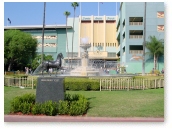 The racetrack is just south of the Foothill Freeway (Interstate 210), across from the Los Angeles County Arboretum, and is bounded by Huntington Drive, Baldwin Avenue, Colorado Street and Colorado Place.
The racetrack is just south of the Foothill Freeway (Interstate 210), across from the Los Angeles County Arboretum, and is bounded by Huntington Drive, Baldwin Avenue, Colorado Street and Colorado Place.
In 1875, Santa Anita Park was part of E. J. "Lucky" Baldwin's enormous Rancho Santa Anita which, at its height, encompassed what is now Sierra Madre, Arcadia, Monrovia, El Monte, Baldwin Park and much more. "Lucky" Baldwin's empire produced wine, brandy, grain, oranges, grapes, lemons, walnuts and raised
herds of sheep, cattle and horses. Most of the Rancho's equine troupe was made up of working horses; a select few, however, would become the ancestry of one of the finest
thoroughbred nurseries in the world. Throughout the 1880s and 1890s, Baldwin raced his horses in California, Chicago, St. Louis and across the east.
He acquired a stable of winners which often finished in first place. With the beginning of the new century, Baldwin embarked on his last endeavor – building his own racetrack.
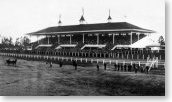 His dream was realized in December 1907 when Santa Anita opened its doors. The racetrack was located off Huntington Drive where Santa Anita Golf Course is today.
The park's grandstand faced north toward the San Gabriel Mountains, just as it does today. Two years later, horse racing was banned across California, and consequently Santa Anita was forced to shut down. The same year "Lucky" Baldwin died. In 1912, the grandstand burned down and the park remained unused until 1917 when Baldwin's daughter, Anita, sold the property to Los Angeles County, who deeded it to the War Department for a U.S. Army Balloon School.
His dream was realized in December 1907 when Santa Anita opened its doors. The racetrack was located off Huntington Drive where Santa Anita Golf Course is today.
The park's grandstand faced north toward the San Gabriel Mountains, just as it does today. Two years later, horse racing was banned across California, and consequently Santa Anita was forced to shut down. The same year "Lucky" Baldwin died. In 1912, the grandstand burned down and the park remained unused until 1917 when Baldwin's daughter, Anita, sold the property to Los Angeles County, who deeded it to the War Department for a U.S. Army Balloon School.
The creation of the U.S. Highway System in 1925 led to plans to widen Huntington Drive and Foothill Boulevard and cut a thoroughfare through the Baldwin Ranch in order to help carry the increased highway traffic. By 1931, the road which is now known as Colorado Place cut through the ranch and connected Huntington Drive with Colorado Boulevard into Pasedena. It was officially recognized as Route 66. In the early 1930s, pari-mutuel betting became legal again in California and Anita Baldwin applied for city zoning and a license to do business as the Los Angeles Jockey Club. In August 1932, excavation began on the Baldwin estate for a new racetrack; however, when the work ended suddenly in March 1933 amidst rumors of unpaid bills, a group of racing enthusiasts called the Los Angeles Turf Club was formed. The group was headed by Hal Roach, the movie producer who gave us Laurel and Hardy, the Little Rascals, and Harold Lloyd. Roach approached Carleton Burke, the racing commission chairman,
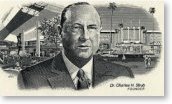 about a slate of winter dates. He also appealed to Gwynn Wilson, athletic director of USC and associate manager of the 1932 Olympic Games in Los Angeles, to take on the task of designing a new racetrack. Believing the success of a new racetrack depended on offering the public first class entertainment, Roach also proposed a $100,000 purse to ensure the participation of quality horses and jockeys. Meanwhile in San Francisco, Dr. Charles Henry Strub and some of his associates had secured the first permit from the newly created California Horse Racing Board. Unsatisfied with sites in Northern California, Strub joined forces with Roach's Turf Club in Los Angeles. Strub literally went door to door selling stock at $5,000 a share in the new venture that Roach billed as “a million dollar track with a $100,000 purse.” These were high stakes for a time when races commonly paid only half that amount. Their efforts were rewarded when 214 acres were purchased from Anita Baldwin. Although Roach had advocated a location nearer to downtown Los Angeles, Burke insisted on the Santa Anita site, given the history of horse racing established by "Lucky" Baldwin. The groundbreaking started in March 1934, just east of the site initially chosen by Anita Baldwin in 1932, and the Park opened on Christmas Day 1934. Attendance for the first day was an astounding 30,777.
about a slate of winter dates. He also appealed to Gwynn Wilson, athletic director of USC and associate manager of the 1932 Olympic Games in Los Angeles, to take on the task of designing a new racetrack. Believing the success of a new racetrack depended on offering the public first class entertainment, Roach also proposed a $100,000 purse to ensure the participation of quality horses and jockeys. Meanwhile in San Francisco, Dr. Charles Henry Strub and some of his associates had secured the first permit from the newly created California Horse Racing Board. Unsatisfied with sites in Northern California, Strub joined forces with Roach's Turf Club in Los Angeles. Strub literally went door to door selling stock at $5,000 a share in the new venture that Roach billed as “a million dollar track with a $100,000 purse.” These were high stakes for a time when races commonly paid only half that amount. Their efforts were rewarded when 214 acres were purchased from Anita Baldwin. Although Roach had advocated a location nearer to downtown Los Angeles, Burke insisted on the Santa Anita site, given the history of horse racing established by "Lucky" Baldwin. The groundbreaking started in March 1934, just east of the site initially chosen by Anita Baldwin in 1932, and the Park opened on Christmas Day 1934. Attendance for the first day was an astounding 30,777.
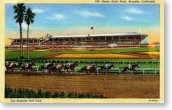 Santa Anita Park's original Turf Club, Club House, and landmark 1,100-foot long, 26,000-seat Grandstand were designed by the noted Los Angeles architect Gordon B. Kaufmann. He blended Spanish-flavor and Art Deco architectural design with colorful landscaping and ornamental sculptures. The Park's giant Infield could accommodate thousands more guests. The entire complex boasts 61 barns, capable of housing more than 2,000 horses and a complete equine hospital.
Santa Anita Park's original Turf Club, Club House, and landmark 1,100-foot long, 26,000-seat Grandstand were designed by the noted Los Angeles architect Gordon B. Kaufmann. He blended Spanish-flavor and Art Deco architectural design with colorful landscaping and ornamental sculptures. The Park's giant Infield could accommodate thousands more guests. The entire complex boasts 61 barns, capable of housing more than 2,000 horses and a complete equine hospital.
Ever since Santa Anita Park opened its doors on Christmas Day 1934, it has been offering first class racing. In 1940, Seabiscuit, one of the most popular horses of
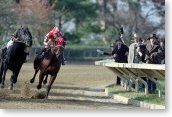 all time, won the Santa Anita Handicap after losing photo decisions (by a nose) in 1937 and 1938 to Rosemont and Stagehand, respectively, and after being sidelined with an injury in 1939. His tenacity to overcome great odds and win the Handicap made Seabiscuit an international celebrity. The 1940 victory was Seabiscuit's last race and became one of the biggest sports stories of that year.
all time, won the Santa Anita Handicap after losing photo decisions (by a nose) in 1937 and 1938 to Rosemont and Stagehand, respectively, and after being sidelined with an injury in 1939. His tenacity to overcome great odds and win the Handicap made Seabiscuit an international celebrity. The 1940 victory was Seabiscuit's last race and became one of the biggest sports stories of that year.
During World War II, racing at Santa Anita was halted as the Park was used by the federal government as one of twelve Japanese American Assembly Centers established in California to provide temporary housing for Japanese awaiting relocation to camps in the U.S. interior. Because of the adequate space and availability of water and electricity, racetracks and fairgrounds were used as assembly centers whenever possible. During this time the Park became known as Camp Santa Anita, a U.S. Army base. Racing resumed at Santa Anita on May 5, 1945.
On March 28, 1958, Dr. Charles Henry Strub, Santa Anita's co-founder, died at age 73. His son, Robert Paul Strub, subsequently became Chairman of the Board and Chief Executive Officer. In 1984, Santa Anita Park received worldwide honors as the site for the equestrian events of that year’s Summer Olympic Games. More than 200,000 people attended the events from July 29 to August 12. On March 3, 1985, the Santa Anita Handicap reached its all-time attendance record of 85,527, and on February 1, 1986, Santa Anita’s highest pari-mutuel payoff occurred when Craig Phillips of Hacienda Heights won $1.9 million by correctly selecting nine winners in the Pick 9 wager.
Chairman and CEO Robert Paul Strub died on May 5, 1993, at the age of 74. In 1997, Meditrust, the nation's leading health care real estate investment trust (REIT), purchased the Santa Anita Companies for more than $340 million. The purchase included the racetrack, various real estate holdings and the company's tax exempt status, which allowed the REIT to earn operating income.
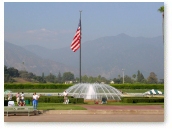 In December 1998, Frank Stronach, an Austrian industrialist and horse owner, purchased Santa Anita Park from Meditrust for $126 million. In the 12 months that followed, Stronach's Magna Entertainment Corp. purchased five other racetracks including Florida's Gulfstream Park, the San Francisco Bay Area's Golden Gate Fields and Bay Meadows Racecourse. The following year, Santa Anita Park completed a $15 million renovation program, the largest and most comprehensive in its history. The Park's magnificent landscaping and grounds are adorned by more than 1,500 trees, an abundance of blooming seasonal and perennial flowers, sparkling fountains, antique statuary and ornamental vases, artistic topiary designs, and verdant lawns. Many of the Park's leafy splendors are indigenous to the San Gabriel Valley. Specimens include ornamental Olive, Brazilian peppers, California peppers, fern pines, blue gum, eucalyptus and the Washingtonian Robusta Palms. Visitors to the oval Infield enjoy outstanding views of the races and nearby San Gabriel Mountains, bright green lawns, colorful plantings, extensive picnic facilities, as well as the Park's playground, Anita Chiquita, which offers slides, jungle gyms, swings and more. The Park's landscaping opulence is maintained all year long by a team of at least 60 gardeners and groundskeepers.
In December 1998, Frank Stronach, an Austrian industrialist and horse owner, purchased Santa Anita Park from Meditrust for $126 million. In the 12 months that followed, Stronach's Magna Entertainment Corp. purchased five other racetracks including Florida's Gulfstream Park, the San Francisco Bay Area's Golden Gate Fields and Bay Meadows Racecourse. The following year, Santa Anita Park completed a $15 million renovation program, the largest and most comprehensive in its history. The Park's magnificent landscaping and grounds are adorned by more than 1,500 trees, an abundance of blooming seasonal and perennial flowers, sparkling fountains, antique statuary and ornamental vases, artistic topiary designs, and verdant lawns. Many of the Park's leafy splendors are indigenous to the San Gabriel Valley. Specimens include ornamental Olive, Brazilian peppers, California peppers, fern pines, blue gum, eucalyptus and the Washingtonian Robusta Palms. Visitors to the oval Infield enjoy outstanding views of the races and nearby San Gabriel Mountains, bright green lawns, colorful plantings, extensive picnic facilities, as well as the Park's playground, Anita Chiquita, which offers slides, jungle gyms, swings and more. The Park's landscaping opulence is maintained all year long by a team of at least 60 gardeners and groundskeepers.
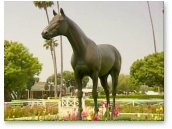 In the Paddock Gardens that encircle the Saddling Barn and Walking Ring, Park guests may enjoy close-up views of the horses, jockeys, and trainers as they prepare for their races. In the center of the Gardens' Walking Ring, surrounded by box hedges, stands a bronze statue of the beloved Seabiscuit. The life-sized statue was sculpted by Ted Wheeler and went on public display in the Paddock Gardens in 1941. It is one of the few life-sized bronzes ever erected to the memory of a horse. Hollywood would eventually pay tribute to this thoroughbred in two films made more than fifty years apart. Although Warner Brothers' The Story of Seabiscuit (1949), starring Shirley Temple and Barry Fitzgerald, is a fictionalized depiction of the famed thoroughbred, it actually uses archived newsreel footage of the real Seabiscuit. The film’s highlighted race sequences are seamlessly interwoven with scenes of then current-day Santa Anita Park. Seabiscuit (2003) is Gary Ross' adaptation of Laura Hillenbrand’s #1 New York Times bestseller Seabiscuit:
In the Paddock Gardens that encircle the Saddling Barn and Walking Ring, Park guests may enjoy close-up views of the horses, jockeys, and trainers as they prepare for their races. In the center of the Gardens' Walking Ring, surrounded by box hedges, stands a bronze statue of the beloved Seabiscuit. The life-sized statue was sculpted by Ted Wheeler and went on public display in the Paddock Gardens in 1941. It is one of the few life-sized bronzes ever erected to the memory of a horse. Hollywood would eventually pay tribute to this thoroughbred in two films made more than fifty years apart. Although Warner Brothers' The Story of Seabiscuit (1949), starring Shirley Temple and Barry Fitzgerald, is a fictionalized depiction of the famed thoroughbred, it actually uses archived newsreel footage of the real Seabiscuit. The film’s highlighted race sequences are seamlessly interwoven with scenes of then current-day Santa Anita Park. Seabiscuit (2003) is Gary Ross' adaptation of Laura Hillenbrand’s #1 New York Times bestseller Seabiscuit:
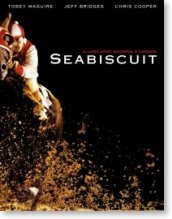 An American Legend, the biographical account of the undersized Depression-era racehorse who lifted the national spirit to great heights. Released by Universal Pictures, the film is directed by Oscar-nominated Ross, narrated by David McCullough, and stars Jeff Bridges as Charles Howard, Chris Cooper as Tom Smith and Tobey Maguire as Red Pollard.
An American Legend, the biographical account of the undersized Depression-era racehorse who lifted the national spirit to great heights. Released by Universal Pictures, the film is directed by Oscar-nominated Ross, narrated by David McCullough, and stars Jeff Bridges as Charles Howard, Chris Cooper as Tom Smith and Tobey Maguire as Red Pollard.
Hollywood's fascination with Santa Anita Park horse racing did not start with the celebrated Seabiscuit. Tinseltown has had a love affair with Santa Anita since it opened in 1934, and it continues today. Probably the first movie to be filmed at Santa Anita Park was Fox Films' In Old Kentucky (1935). The movie was directed by George Marshall and starred Will Rogers and Dorothy Wilson.
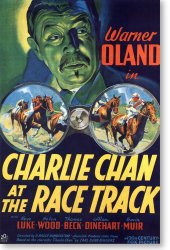 The following year, Charlie Chan (Warner Oland) and his Number One Son (Keye Luke) corralled crooked gamblers during an investigation of a horse owner's murder at Santa Anita in Charlie Chan at the Race Track (1936). In Metro-Goldwyn-Mayer's A Day at the Races (1937), the Marx brothers wreak havoc at the racetrack. Also in 1937, Santa Anita showed up on the silver screen in United Artist's story of a self-destructive actor who marries a young movie hopeful in William A. Wellman's A Star is Born (1937), starring Fredric March and Janet Gaynor. In the 1940s, Santa Anita was a location site of Alfred Hitchcock's adaptation of Ben Hecht’s espionage tale, Notorious (1946), starring Cary Grant and Ingrid Bergman, and of Ray McCarey's crime mystery, The Falcon's Alibi (1946), based on Michael Arlen's literary character The Falcon starring Tom Conway.
The following year, Charlie Chan (Warner Oland) and his Number One Son (Keye Luke) corralled crooked gamblers during an investigation of a horse owner's murder at Santa Anita in Charlie Chan at the Race Track (1936). In Metro-Goldwyn-Mayer's A Day at the Races (1937), the Marx brothers wreak havoc at the racetrack. Also in 1937, Santa Anita showed up on the silver screen in United Artist's story of a self-destructive actor who marries a young movie hopeful in William A. Wellman's A Star is Born (1937), starring Fredric March and Janet Gaynor. In the 1940s, Santa Anita was a location site of Alfred Hitchcock's adaptation of Ben Hecht’s espionage tale, Notorious (1946), starring Cary Grant and Ingrid Bergman, and of Ray McCarey's crime mystery, The Falcon's Alibi (1946), based on Michael Arlen's literary character The Falcon starring Tom Conway.
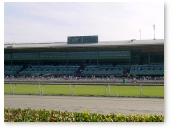 Santa Anita not only attracted Hollywood notables as a film location; its horseracing was very popular among early show business tycoons and movie stars. Some of the famous Hollywood celebrities who owned horses included Bing Crosby, George Raft, Spencer Tracy, Errol Flynn and Al Jolson. Prominent producers and movie executives with their own stables included Louis B. Mayer, Harry M. Warner and Darryl F. Zanuck. Santa Anita Park's box holders included such VIPs as Cecil B. de Mille, Frank Capra, Fred Astaire, Jack Benny and Walt Disney. Today, Hollywood's elite continues its fascination with Santa Anita, as both fans and horse owners. Whoopi Goldberg, Jack Nicholson, Cybill Shepard, Michelle Pfeiffer, Joe Pesci, Steven Bochco, Melissa Joan Hart, Laurie Metcalf, Donnie Osmond, Michael
Santa Anita not only attracted Hollywood notables as a film location; its horseracing was very popular among early show business tycoons and movie stars. Some of the famous Hollywood celebrities who owned horses included Bing Crosby, George Raft, Spencer Tracy, Errol Flynn and Al Jolson. Prominent producers and movie executives with their own stables included Louis B. Mayer, Harry M. Warner and Darryl F. Zanuck. Santa Anita Park's box holders included such VIPs as Cecil B. de Mille, Frank Capra, Fred Astaire, Jack Benny and Walt Disney. Today, Hollywood's elite continues its fascination with Santa Anita, as both fans and horse owners. Whoopi Goldberg, Jack Nicholson, Cybill Shepard, Michelle Pfeiffer, Joe Pesci, Steven Bochco, Melissa Joan Hart, Laurie Metcalf, Donnie Osmond, Michael
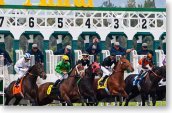 Bottualuci, Steve Harris and Wendie Malick are just some of the rich and famous who enjoy the races. Celebrity horse owners who race their horses at Santa Anita include Mark McGrath (lead singer of Sugar Ray), Gary Barber (producer of The Sixth Sense), Alex Trebek (host of Jeopardy!), Don Johnson (star of Nash Bridges), David E. Kelley (award-winning producer and creator of Ally McBeal and The Practice), Herb Alpert (six-time Grammy award-winning musician), Burt Bacharach (internationally acclaimed singer, composer, producer and conductor), David Milch (writer and executive producer of NYPD Blue) and brothers Michael and Roger King of King World Productions (distributor of Wheel of Fortune, Jeopardy! and The Oprah Winfrey Show).
Bottualuci, Steve Harris and Wendie Malick are just some of the rich and famous who enjoy the races. Celebrity horse owners who race their horses at Santa Anita include Mark McGrath (lead singer of Sugar Ray), Gary Barber (producer of The Sixth Sense), Alex Trebek (host of Jeopardy!), Don Johnson (star of Nash Bridges), David E. Kelley (award-winning producer and creator of Ally McBeal and The Practice), Herb Alpert (six-time Grammy award-winning musician), Burt Bacharach (internationally acclaimed singer, composer, producer and conductor), David Milch (writer and executive producer of NYPD Blue) and brothers Michael and Roger King of King World Productions (distributor of Wheel of Fortune, Jeopardy! and The Oprah Winfrey Show).
The 320-acre Santa Anita Park is presently owned and operated by Magna Entertainment Corp., whose network of thoroughbred racetracks includes Gulfstream Park, Pimlico Race Course, Laurel Park, Lone Star Park at Grand Prairie,
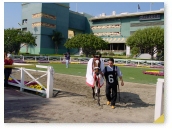 Golden Gate Fields, Bay Meadows, Thistledown, Remington Park, Portland Meadows and Great Lakes Downs. The Park opens each year on December 26, with daily racing through late April. Santa Anita's annual fall meeting, presented by the Oak Tree Association, takes over the track from early October to early November. The Park's Infield opens weekends, holidays and Opening Day. Box Seat accommodations are offered on or near the finish line for full season or daily admission. Comfortable race viewing with full wagering services is available at the Turf Club, which features fine dining on the Turf Terrace and in the Americana Room. Santa Anita Park also offers broadcasts of live racing and simulcast racing on television monitors in an attractive sports bar setting at the John Henry Room. Patrons to the Turf Club and John Henry Room are required to adhere to the recommended dress code of each.
Golden Gate Fields, Bay Meadows, Thistledown, Remington Park, Portland Meadows and Great Lakes Downs. The Park opens each year on December 26, with daily racing through late April. Santa Anita's annual fall meeting, presented by the Oak Tree Association, takes over the track from early October to early November. The Park's Infield opens weekends, holidays and Opening Day. Box Seat accommodations are offered on or near the finish line for full season or daily admission. Comfortable race viewing with full wagering services is available at the Turf Club, which features fine dining on the Turf Terrace and in the Americana Room. Santa Anita Park also offers broadcasts of live racing and simulcast racing on television monitors in an attractive sports bar setting at the John Henry Room. Patrons to the Turf Club and John Henry Room are required to adhere to the recommended dress code of each.
As one looks out from the Grandstand across the Track and Infield to the beautiful backdrop of the San Gabriel Mountains, it is no wonder that filmmakers and visitors alike find it hard to imagine a more perfect setting for horse racing than Santa Anita Park. LIGHTS! CAMERA! ACTION!